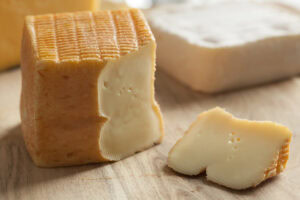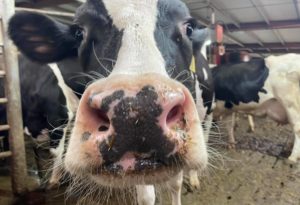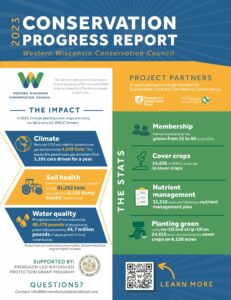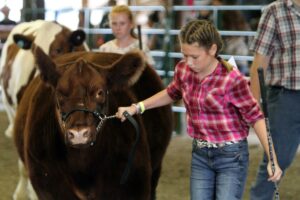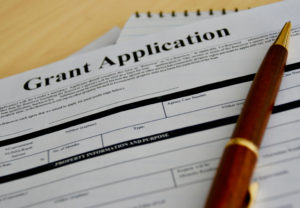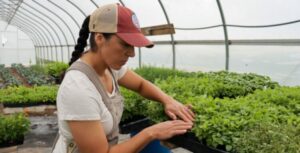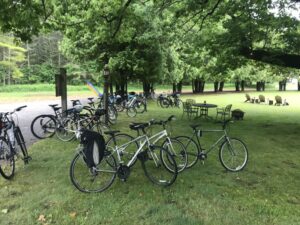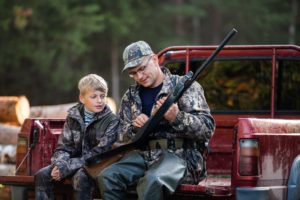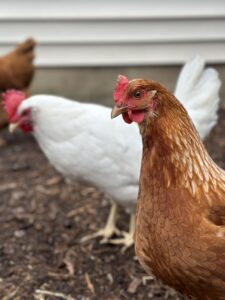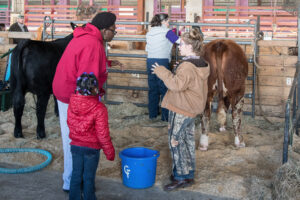Limburger – It’s Part Of Wisconsin’s Heritage
Limburger cheese has a reputation for its potent aroma, but it’s also a staple in Wisconsin’s cheese-making heritage.
One of Limburger’s biggest fans, John Jaeggi, is the coordinator for the Wisconsin Master Cheese Maker program at the Center for Dairy Research. He’s also a go-to judge for the “stinky cheese” categories at competitions.
He says there’s a historical aspect to Limburger cheese in Wisconsin because of the immigrants who came here during the 1800s from Switzerland and Germany who specialized in surface-ripened cheeses. A surface-ripened cheese means there are bacteria, yeasts, and molds that are supposed to grow on the rind for production and aging. That bacteria has a stink!
Limburger was popular in the early 1900s — Kraft Foods was heavily involved in production. Jaeggi says Limbruger started falling out of favor in the mid-1900s. That’s when cartoons and other elements of pop culture at the time used Limburger cheese as the butt of a joke, giving the cheese a stinky reputation. Also at that time, more cheese varieties started to emerge.
Jaeggi says there are a lot of cheeses out there that have a similar flavor profile to Limburger that consumers are driven toward. What people don’t know is that foods like nacho cheese (the kind you’d find over a plate of chips at the ballpark) use Limburger cheese as an ingredient.
Jaeggi enjoys it on rye bread with mustard and sweet onion. He recommends making Monroe Cheese Days a destination Sep. 20-22 for the Limburger tasting contest.
Wisconsin Has A Unique System In Place
The Highly Pathogenic Avian Influenza is circulating again, but it’s impacting more than birds. Several states have found this strain of bird flu in dairy cows. Wisconsin has not had a case this year, but it has a system to help prevent the spread of animal disease.
Wisconsin requires anyone with livestock – whether you have three chickens or 3,000 cows – to register where those animals live. It’s the Premise ID Law. The Wisconsin Livestock Identification Consortium runs the database.
WLIC Executive Director Julie Sweney says this information can be critical in stopping the spread of disease.
What’s unique about how Wisconsin stores this information is that WLIC is separate from the government. This means your information is confidential and not subject to the Freedom of Information Act.
The Department of Agriculture, Trade, and Consumer Protection uses your contact information to alert you if your animals are at risk of a disease outbreak.
Have you moved or gotten a new phone number or email address? Have you recently taken on a fair animal project or added species to your herd? You can update your premise information at https://wiid.org/
Access the USDA list of detections in domestic livestock: https://www.aphis.usda.gov/livestock-poultry-disease/avian/avian-influenza/hpai-detections/livestock
Sign up for updates on H5N1 in cattle from the state Department of Agriculture, Trade and Consumer Protection: https://service.govdelivery.com/accounts/WIDATCP/subscriber/new
Western WI Farmers Conservation Efforts Payoff
Skip Grosskreutz is continuing to experiment with new sustainable farming practices and motivated by the betterment he sees for the entire community.
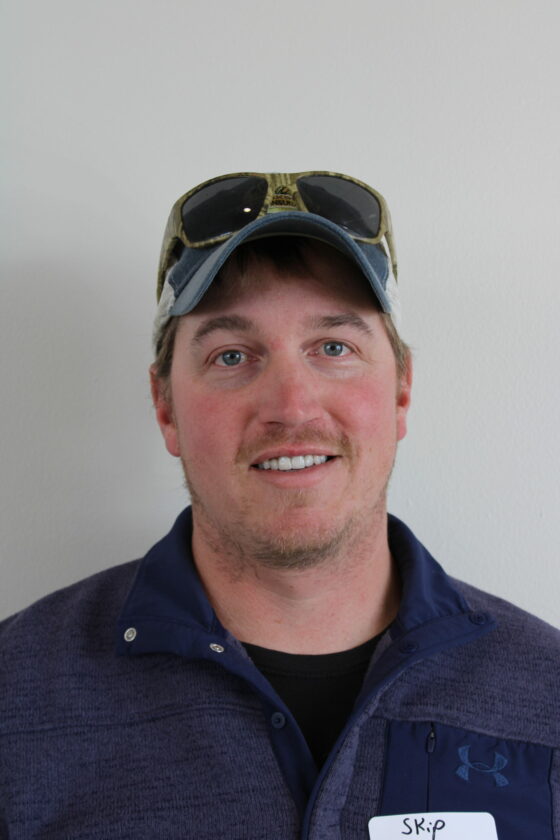
Grosskreutz is an agribusiness and farm insurance specialist at his family’s business, Grosskreutz Crop Insurance, in Clear Lake; he’s also been a crop farmer for about 17 years now. Growing up on a 50-cow dairy farm, his passion for agriculture has been ingrained in him since birth.
Sustainable farming practices, such as cover cropping and no-till usage, are prevalent on Grosskreutz’s farm today, but that wasn’t always the case.
“We used to till the ground like everyone did in the past,” he said. “I started doing research and testing out no-till. We implemented cover cropping about 10 years ago now and have seen the benefits of less soil erosion, less run-off and all the good things that go along with it.”
The main benefit Grosskreutz noticed because of cover cropping was the increase in organic matter.
“We take soil samples every three years, and our organic matter has continued to increase for as long as
we’ve been doing this,” he said.
Transitioning to cover cropping takes time and certainly doesn’t happen all at once.
“Originally, we just tried cover crops on a small portion of our acres, and then eventually we did it on
half of them. Now we’re doing it on all our acres,” Grosskreutz said. “Another thing we’re trying is
putting rye on some of our acres, taking it off in July or early August, having more of a long season cover
crop. It’s neat to see how the ground responds to this.”
Grosskreutz joined the Western Wisconsin Conservation Council a year ago thanks to the
encouragement of a fellow farmer. He enjoys collaborating with others in the group as well as
participating in the group’s events.
“I’ve learned a lot through our field events and meetings,” he said. “It’s interesting to learn what other
people are doing and what their goals are.”
Annual survey results
Grosskreutz is motivated by the group’s 2023 Member Conservation Practice Survey results to continue
learning and improving for the benefit of the whole community.
The group, composed of 60 farmers, implemented various conservation practices: planting 14,636 acres
of cover crops, using no-till and strip-till on 24,618 acres and planting into cover crops (otherwise known
as “planting green”) on 6,128 acres. They also measured nutrient management impact on 32,318 acres.
The potential environmental benefits of these practices:
- Reduction of greenhouse gas emissions by 4,249 metric tons of carbon dioxide equivalents, which is equal to greenhouse gas emissions produced by 1,101 cars driven in a year.
- Prevention of sediment loss from farm fields of 81,262 tons, equivalent to 8,126 dump trucks’ worth of soil.
- Reduction of phosphorus runoff by 89,478 pounds, potentially preventing 44.7 million pounds of algae growth in local water bodies.
Data was analyzed and verified by Farmers for Sustainable Food and the Wisconsin Department of
Agriculture, Trade and Consumer Protection.
As one of the group’s close partners, The Nature Conservancy is proud to see the results of the hard
work members of this producer-led watershed group are putting toward conservation.
“A great example of the group’s commitment to conservation is a year-over-year steady increase in farm
acres under improved nutrient management practices such as the adoption of variable rate technology
and split application of fertilizers,” Ricardo Costa, TNC’s associate director of agriculture strategies in
Wisconsin, said. “These practices not only benefit the farm’s bottom line by decreasing costs associated with the application of fertilizers but also the environment by reducing the possibility of excess nutrients
getting to our lakes and streams.”
Grosskreutz has set impressive conservation goals for the group and for farming throughout the state.
“My goal as a WWCC member is to have cover crops planted on all the acres in Wisconsin,” Grosskreutz
said. “I know it’s an ambitious goal, but that’s what we’re striving for.”
By the numbers:
Number of acres covered by conservation practices among Western Wisconsin Conservation Council
members:
- 2018 ― 26,841
- 2019 ― 101,514
- 2020 ― 155,520
- 2021 ― 159,932
- 2022 ― 145,295
- 2023 ― 174,877
Potential impact of conservation practices:
- Phosphorus runoff reduction ― 89,478 pounds
- Sediment erosion reduction ― 81,262 tons
- Carbon dioxide emission reduction ― 4,249 metric tons
Time To Get State Fair Ear Tags
As you prepare your animal projects for the Wisconsin State Fair, don’t forget to buy your 840 ear tags and DNR sample envelopes.
DNA identification technologies have proven to be instrumental in safeguarding the reputation and integrity of Wisconsin’s youth livestock programs. You must submit DNA identification to be eligible for all 2024 Wisconsin State Fair Championship awards in the market and non-registered breeding stock shows of the Junior Beef, Boer & Market Goat, Sheep, and Swine Divisions.
Wisconsin State Fair’s process for 2024 DNA identification is:
Non-registered Boer Goat Does must also have 840 tags and DNA samples.
Wisconsin State Fair requires an 840 ear tag as official animal identification. The preferred ear tag is the 840 RFID, but any official 840 ear tag will do. The fair recognizes the 15-digit sequence of numbers beginning with “840” as the individual animal identification number. Wisconsin State Fair says the 840 RFID ear tags will speed up unloading and check-in procedures.
Wisconsin State Fair requires DNA sample envelopes to collect and submit DNA samples. You can buy envelopes from the Wisconsin State Fair or county fair programs that use Animal ID Inc. as their DNA service provider. You must return envelopes to the state or county fair from which you bought them. Wisconsin State Fair will not accept DNA samples for processing that are not in official Wisconsin State Fair envelopes.
You must identify sample envelopes in the exhibitor’s name or immediate family member’s name. If using the immediate family names, all siblings’ names MUST appear on both the envelope and the DNA Identification document. Wisconsin State Fair does not consider cousins as immediate family.
Wisconsin State Fair DNA identification 840 ear tags and sample envelopes are available for purchase online by credit card at entry.wistatefair.com.
- DNA Identification Sample Envelope: $8.00
- 840 RFID Ear Tag: $8.00
- DNA Identification Sample Envelope and 840 RFID Ear Tag: $16
If you’re sending DNA sample envelopes to the Wisconsin State Fair, you MUST return them via mail, Fed Ex, or UPS. Address envelopes to: Wisconsin State Fair, Agriculture Department, 640 S 84th St, West Allis WI 53214
The deadlines to return DNA identification sample envelopes are in May to be eligible for champion awards. Please contact Wisconsin State Fair at entryoffice@wistatefair.com with additional DNA identification questions.
Clean Sweep Grant Applications Now Available
Applications for 2025 Clean Sweep grants are now available for the collection and disposal of agricultural waste and farm chemicals, household hazardous waste, and unwanted prescription drugs.
Counties, cities, towns, villages, Tribal nations, regional planning commissions, sewerage districts, municipal law enforcement, public health departments, and combinations of the aforementioned entities are eligible to apply. However, only counties are eligible for agricultural pesticide grants.
Interested applicants will find a link to the 2025 grant application materials on DATCP’s Clean Sweep webpage at https://datcp.wi.gov/Pages/Programs_Services/CleanSweep.aspx.
Clean Sweep also offers an online application for grants through the Clean Sweep SharePoint site. Instructions and supporting information are available at the webpage linked above. If you are interested in the online application, you are encouraged to set up an account now and then return to the online application later for completion.
The Wisconsin Log-on Management System (WILMS) is used to access the Clean Sweep SharePoint site. For more information, follow the instructions in the guidance document that is available on the webpage linked above. There are instructions for new users and returning users. If you are a returning user, please use the username and password you set up last year. If you forgot your username and password, the instructions also contain information on how to recover those.
Completed applications are due by 11:59 p.m. on Friday, May 24, 2024. Grant funding will be announced on or before August 1, 2024.
You can submit completed applications via the online SharePoint system, email, or postal mail. Mailed applications must be postmarked by the deadline.
Reminder for Clean Sweep grant recipients
Beginning with 2021 Clean Sweep grant final reports, recipients must provide itemized invoices or receipts for all expenses listed on expense reimbursement forms (except salaries, continue to use the Labor Worksheet for any salary expenses).
New for 2025
The new grant maximums for the 2025 Clean Sweep program have been changed from previous years maximums. Beginning in 2025, the Household Hazardous Waste program will be allocated $775,000, Agriculture is allocated $175,000, and the Unwanted Prescription Drug collection is allocated $50,000. Additionally, the requests maximums for single municipalities in the Household Hazardous Waste program have increased and are as follows:
| Proposed Maximum Requests | |
| Permanent | $25,000.00 |
| Continuous | $22,000.00 |
| Temporary | $20,000.00 |
If you have any questions, please contact Dan Way by email at DATCPcswp@wisconsin.gov or by phone at either (608) 224-4545 or (608) 292-0615.
NRCS Announces Second 2024 EQIP & RCPP Signup
Farmers and forest landowners will want to plan ahead and sign up early for United States Department of Agriculture (USDA) Natural Resources Conservation Service (NRCS) conservation funding. Josh Odekirk, NRCS Acting State Conservationist in Wisconsin, announced that farmers and forest landowners interested in Environmental Quality Incentives Program (EQIP) or Regional Conservation Partnership Program (RCPP) producer contracts need to apply by May 17, 2024, for the second round of funding in fiscal year 2024.
USDA recognizes the need to be inclusive of all people and ensure equitable access to services. Increased financial assistance for conservation practices, dedicated conservation funding, and access to advance payments for conservation practice implementation are being offered to socially disadvantaged groups, as identified by NRCS.
Although NRCS accepts applications year-round at all USDA Service Centers in Wisconsin, applications received after May 17, 2024 will automatically be deferred to the next funding cycle, so interested producers are encouraged to apply now.
Enjoy A Farm and Field Bike Tour
Gathering Ground is hosting its fourth annual Island Farm and Field Bike Tour — History Edition. It will take place on Friday June 28 at 9 am. This unique event celebrates the island’s rich agricultural heritage as well as provides a behind the scenes look at the farms working today to provide fresh and local products to the community.
Participants will embark on a scenic journey through seven sites around the Island. Led by knowledgeable guides, attendees will have the opportunity to hear stories from farmers and residents, gaining valuable insights into the island’s agricultural practices, both historical and contemporary. As well as enjoy a lunch catered by Jackson Harbor Soup and Hoot Blossom Farm. Attendees will also have the chance to savor the flavors of Island Orchard Cider during a special cider tasting session. Vegetarian and gluten free options will be available as well.
“We’re excited to offer attendees a firsthand experience of the island’s vibrant agricultural landscape,” said Alessandra Rolffs, Executive Director at Gathering Ground. “Through events like the Island Farm and Field Bike Tour, we aim to raise awareness about the importance of sustainable agriculture while showcasing the beauty of our island’s farming heritage.”
For those in need of e-Bikes, Island Adventure Company offers rentals. With only 45 tickets available, spaces are limited. Interested individuals are encouraged to register as soon as possible to secure their spot for this unforgettable experience.
Tickets can be purchased at gatheringgroundwi.org.
Wisconsin Seeks Hunter Educators
The Wisconsin DNR is looking for volunteers passionate about promoting safe, responsible, and ethical hunting practices to serve as hunter education instructors. Volunteer opportunities are available in all parts of the state.
Since the program’s creation in 1967, more than 20,000 volunteer instructors have trained and certified more than 1 million hunters statewide. These efforts have helped make hunting a much safer activity, including a 95 percent decrease in hunting-related incidents since the start of the program.
“The success of the hunter education program over the years has been a direct result of the exceptional quality and dedication of the instructors we’ve had teaching classes,” says Michael Weber, DNR Hunter Education Administrative Warden. “Volunteer instructors have been, and continue to be, the backbone of this critical program. Whether you’ve been hunting for years or are new to the sport, please consider applying.”
In addition to shaping the future of Wisconsin’s hunting tradition, becoming a volunteer instructor is a great way to obtain hands-on teaching experience, work closely with DNR staff, and engage with your local community.
There are two ways to become a certified volunteer hunter education instructor. Interested volunteers can either serve as apprentices under a sponsoring instructor for at least two complete courses or attend a certification training session hosted by a DNR Outdoor Skills Trainer.
Once certified, the DNR provides volunteer instructors with all the materials and equipment required to teach a hunter education course. Instructors must only teach one class every three years to remain certified, although many teach more.
Learn more: https://widnr.widen.net/s/sgbvkbx95s/outdoorskillstraineradministrativemap
Keep An Eye On HPAI
As the spring migration continues, highly pathogenic avian influenza continues to threaten wild and domestic birds.
In addition to the response to HPAI in poultry in certain states across the nation, federal agencies are also working with states on the emerging disease of HPAI in dairy cattle.
Access the USDA list of detections in domestic livestock: https://www.aphis.usda.gov/livestock-poultry-disease/avian/avian-influenza/hpai-detections/livestock
Sign up for updates on H5N1 in cattle from the state Department of Agriculture, Trade and Consumer Protection: https://service.govdelivery.com/accounts/WIDATCP/subscriber/new
DATCP continues to urge all poultry owners to implement strong biosecurity measures to protect their birds from HPAI. As a reminder, signs of HPAI in infected birds include:
- Sudden death without clinical signs
- Lack of energy or appetite
- Decrease in egg production; soft, misshapen eggs
- Purple discoloration of wattles, comb, and legs
- Difficulty breathing
- Runny nose, coughing, sneezing
- Stumbling or falling down
- Diarrhea
There are several ways to report signs in commercial and backyard poultry flocks or to ask questions:
- Report illness in domestic poultry: (608) 224-4872 or by email at DATCPanimalimports@wisconsin.gov. If reporting during evenings and weekends, call (800) 943-0003, choose option 2 when prompted, and tell the duty officer that you are reporting a potential animal disease.
- Report illness in wild birds: Contact the Wisconsin DNR at (608) 267-0866 or by email at DNRWildlifeSwitchboard@wisconsin.gov.
- DATCP media line: (608) 224-4902. Leave a message with any questions or concerns, and your call will be returned as soon as possible.
Does 4-H Have What You Need In Employees?
Heads, hearts, hands and health – they’re the four pillars of 4-H, but how do they play into businesses needs for future employees? That’s what the University of Wisconsin Extension service is asking in a survey they’re conducting this month.
Jill Jorgensen is a WI Youth Development 4-H Animal Science and Agriculture Outreach Specialist in Green Bay trying to drum up some business for the survey. She says their goal is simple, try to get 300 completed survey’s from the state’s business and agribusiness employers before the end of April. Jorgensen the survey will take less than 10 minutes and needs to be filled out by someone over the age of 18 with insights into how the business/agribusiness operates. Respondents can use the QR code below with their smart phones, or access the survey via this link to the Wisconsin Food, Agriculture, & Related Businesses Workforce Needs Survey

Jorgensen says all of the data collected will be shared to help improve programming and the skill set areas identified in the survey as important to employers. She explains more about the survey with Pam Jahnke.

